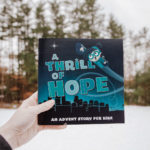I don’t think I learned the word “Advent” until I went to college. I grew up in a little country church, and we didn’t do Advent. We did Christmas. We didn’t do Lent. We did Easter. It wasn’t until I began my ministry preparation and got out of my little bubble that I even knew Advent was a thing. Maybe this describes your own upbringing. Or maybe it describes your church context now. I mean, the Hallmark channel, Starbucks, Target—it’s Christmas at these places right after Thanksgiving. It’s been Christmas at Hobby Lobby since August. Why should it be any different for us?
Let’s talk about three ways to help us think about Advent in our ministries to kids and families this year.
1) Talk about Advent. Advent helps us to live in the anticipation of Jesus’s coming. It gives us an opportunity to identify with God’s people, who were eagerly awaiting a Savior. The celebration is much sweeter when you participate in the anticipation!
I wrote a blog a while back that offers a simple way to talk about Advent and its importance with your kids. I won’t retell the story. Instead, you can check it out here. Now think of something you really looked forward to. What did you do to prepare? How did your preparation make the event you anticipated that much better? Use that story as a simple way to talk about Advent with kids.
2) Use the Lectionary. I get it. Christmas is the same story every year. I mean, it’s a great story, obviously, and one that needs to be told time and time again, but does it get a little stale? How can we improve our telling? How do we keep it fresh? I suggest following the Lectionary!
Let’s talk about why the Lectionary offers what it offers. While we recognize Advent as the time leading up to and preparing us for the Christmas season, Advent has also traditionally referred to the second coming of Jesus. Christmas is the incarnation (enfleshment) of Christ, and his second coming is his second incarnation. Therefore, you’ll find themes of the second coming woven throughout the Advent Lectionary scriptures. This year, for example, the first Lectionary gospel reading in the Advent season is from Luke 21, and it’s about the second coming, looking to the future. If you follow the Lectionary for direction during the Advent season, hopefully this helps you understand why you run into so many second coming passages when you’re trying to figure out how to talk about the first coming.
The Lectionary helps point us to other important characters as we understand what it means to prepare for Christ’s coming. John the Baptist, for example, is often a part of the Lectionary readings. Why? Doesn’t he come after Christmas? Sure, but his role was to prepare the way for Jesus, which is exactly what’s happening in the Advent season. So, instead of telling a chronological story, we can focus on themes of preparation and anticipation.
You don’t have to try to break up the Christmas story to make it last a month. “Uh, week one we’ll do the angels. Week two, the shepherds. Week three—the little drummer boy?” Instead, tell stories of preparing for Jesus’s coming. This year, Jeremiah 33 kicks off the Advent Lectionary readings with a christological prophecy (hundreds of years of anticipation!). As you prepare for Christmas, let your teaching do the same through these scriptures!
If you’re new to using the Lectionary, here’s an easy and interactive way to access it. That link will take you straight to Advent 2018.
3) Help kids connect with the story at home. So you’re doing Advent at church. You’re following the Lectionary. You’re nailing it! But at home kids are getting Elf on the Shelf and school Christmas parties. How do you help them experience the same narrative at home that they’re hearing at church?
One of the easiest ways is to offer an Advent calendar that families can do together. There are several options out there that are interactive—more than just opening a little window to get a piece of candy. Some have coloring pages, things you can cut and tape, or readings or activities. Remember, like anything you send home, if it’s too in-depth, only your homeschooliest families will do it. But if there’s not enough to it, people won’t feel it’s worth it. You’ve got to find an Advent calendar that falls in the sweet spot: robust enough to feel like it’s worth everyone’s time but doesn’t require them to spend thirty minutes every day on it (because they won’t).
They’re out there, though. A simple Advent calendar will help your kids prepare for Christmas, even though Netflix and Walmart say Christmas is already here.
 Well, if you read this far, maybe you’ve got time for a teensy bit more. Our Foundry Kids team wrote and illustrated a book this year called A Thrill of Hope: An Advent Story for Kids. We wanted a story kids and families could engage. We wrote it with all of the things above in mind. It focuses on preparing for Jesus. It uses Lectionary themes. It includes an Advent calendar that is interactive but not overly in depth. The story drives toward one ultimate goal but leaves a cliffhanger each day that keeps kids wanting to read more. It can be read together as a family, or each kid can have their own to read and work through.
Well, if you read this far, maybe you’ve got time for a teensy bit more. Our Foundry Kids team wrote and illustrated a book this year called A Thrill of Hope: An Advent Story for Kids. We wanted a story kids and families could engage. We wrote it with all of the things above in mind. It focuses on preparing for Jesus. It uses Lectionary themes. It includes an Advent calendar that is interactive but not overly in depth. The story drives toward one ultimate goal but leaves a cliffhanger each day that keeps kids wanting to read more. It can be read together as a family, or each kid can have their own to read and work through.
We also created an app that serves as a companion to the book. Each week of Advent, a new song will release that goes along with the story. You can preview one of the songs available on the app below! The app also has discussion questions and bonus coloring pages.
There’s a daily Advent devotional for adults that goes by the same name: A Thrill of Hope. Both books follow the same themes and use the same memory verses each week. The storybook introduces fun and exciting fictional characters who are all preparing for something really big to happen. We’re pleased with the way the book turned out, and we’d be thrilled if your kids and families in your churches got one of these books this year! Check out the variety of ordering options here.
Blessings to you this Advent season. Prepare well now so you can teach your kids and families to prepare well in a couple weeks!





0 Comments